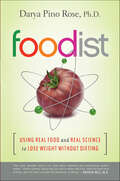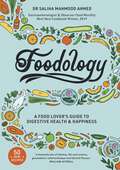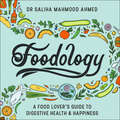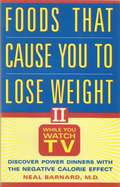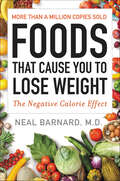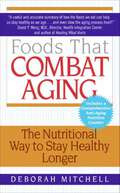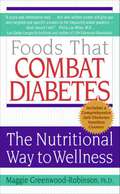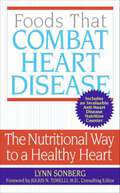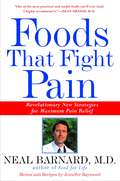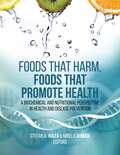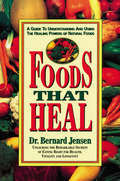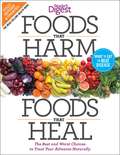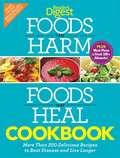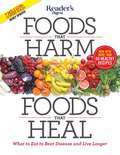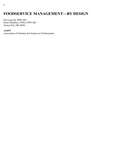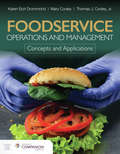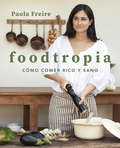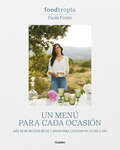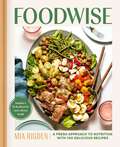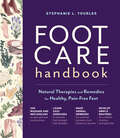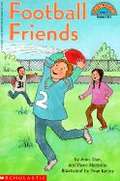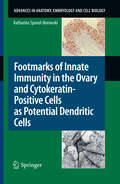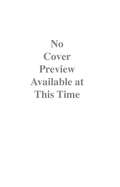- Table View
- List View
Foodist: Using Real Food and Real Science to Lose Weight Without Dieting
by Darya Pino RoseIn Foodist, Darya Pino Rose, a neuroscientist, food writer, and the creator of SummerTomato.com, delivers a savvy, practical guide to ending the diet cycle and discovering lasting weight-loss through the love of food and the fundamentals of science. A foodist simply has a different way of looking at food, and makes decisions with a clear understanding of how to optimize health and happiness. Foodist is a new approach to healthy eating that focuses on what you like to eat, rather than what you should or shouldn’t eat, while teaching you how to make good decisions, backed up by an understanding of what it means to live a healthy lifestyle.Foodist: Using Real Food and Real Science to Lose Weight Without Dieting is filled with tips on food shopping, food prep, cooking, and how to pick the right restaurants and make smart menu choices.
Foodology: A food-lover's guide to digestive health and happiness
by Saliha Mahmood Ahmed'A spicy educational treat to be savoured: a delight.' Tim SpectorThe book will take you on a joint culinary and scientific journey through the gut. It is an unapologetic celebration of what I believe to be the most amazing organ of the body, that will enhance and enlighten the way you cook and eat. Saliha Mahmood AhmedWritten by a gastroenterologist and award-winning food writer, Foodology offers a unique perspective on the joy of eating. Explaining the process of digestion and how the food we eat influences the way we feel, Saliha draws on the latest science and her own experiences as both a doctor and a cook, to bring the subject to life. From childhood memories of devouring Indian street food to why munching on a jam doughnut brings gastronomic happiness, Saliha also offers 50 new, simple, delicious and mostly vegetarian recipes to help you explore your gut health and find your own gastronomic happiness.Foodology takes you on a journey from the first smell of food and bite of goodness through to the time it takes for food to leave the system, and all the processes in between. Have you ever thought about why certain smells can make your mouth water, how the texture of food can impact your taste and why some foods can make you bloat? Saliha takes you on an extensive journey through the gut to show you the true joy of food and why gastronomic happiness is so important to our lives.'A great book for anyone who wants to cook a very tasty supper that hits the spot and also get to know their bodies, moods and emotions better. Foodology is both fascinating and full of delicious meals to enjoy cooking.' Melissa Hemsley'This is a book in the finest tradition of narrative recipe writing. It's a heavenly mix of whimsy, life and science, grounded in solid technique and blissful flavour.' William Sitwell
Foodology: A food-lover's guide to digestive health and happiness
by Saliha Mahmood Ahmed'A spicy educational treat to be savoured: a delight.' Tim SpectorThe book will take you on a joint culinary and scientific journey through the gut. It is an unapologetic celebration of what I believe to be the most amazing organ of the body, that will enhance and enlighten the way you cook and eat. Saliha Mahmood AhmedWritten by a gastroenterologist and award-winning food writer, Foodology offers a unique perspective on the joy of eating. Explaining the process of digestion and how the food we eat influences the way we feel, Saliha draws on the latest science and her own experiences as both a doctor and a cook, to bring the subject to life. From childhood memories of devouring Indian street food to why munching on a jam doughnut brings gastronomic happiness, Saliha also offers 50 new, simple, delicious and mostly vegetarian recipes to help you explore your gut health and find your own gastronomic happiness.Foodology takes you on a journey from the first smell of food and bite of goodness through to the time it takes for food to leave the system, and all the processes in between. Have you ever thought about why certain smells can make your mouth water, how the texture of food can impact your taste and why some foods can make you bloat? Saliha takes you on an extensive journey through the gut to show you the true joy of food and why gastronomic happiness is so important to our lives.'A great book for anyone who wants to cook a very tasty supper that hits the spot and also get to know their bodies, moods and emotions better. Foodology is both fascinating and full of delicious meals to enjoy cooking.' Melissa Hemsley'This is a book in the finest tradition of narrative recipe writing. It's a heavenly mix of whimsy, life and science, grounded in solid technique and blissful flavour.' William Sitwell
Foodology: A food-lover's guide to digestive health and happiness
by Saliha Mahmood AhmedA game-changing exploration of the amazing organ that is the human gut, which will transform your relationship with food.The book will take you on a joint culinary and scientific journey through the gut. This is not a book about 'dieting' in the conventional sense, nor is it a didactic manual on how to make each and every food decision in life. It is an unapologetic celebration of what I believe to be the most amazing organ of the body, that will enhance and enlighten the way you cook and eat. Saliha Mahmood AhmedWritten by a consultant gastroenterologist and award-winning food writer, Foodology offers a unique perspective on the joy of eating. Explaining the process of digestion and how the food we eat influences the way we feel, Saliha draws on the latest science and her own experiences as both a doctor and a cook, to bring the subject to life. From childhood memories of devouring Indian street food to why munching on a jam doughnut brings gastronomic happiness, Saliha offers simple, delicious and mostly vegetarian recipes to help you explore your gut health and find your own gastronomic happiness.Foodology takes you on a journey from the first smell of food and bite of goodness through to the time it takes for food to leave the system, and all the processes in between. Have you ever thought about why certain smells can make your mouth water, how the texture of food can impact your taste and why some foods can make you bloat? Saliha takes you on an extensive journey through the gut to show you the true joy of food and why gastronomic happiness is so important to our lives.(P)2021 Hodder & Stoughton Limited
Foods That Cause You to Lose Weight While You Watch TV: Discover Power Dinners with The Negative Calorie Effect
by Neal Barnard30 FOODS TAT CAUSE YOU TO LOSE WEIGHT. Men and women who have tried them lost weight. Proven results. NEW DISCOVERIES: Amazing Power Dinners with the NEGATIVE CALORIE EFFECT. The completely new FOODS THAT CAUSE YOU TO LOSE WEIGHT II reveals how calorie burning POWER DINNERS can turn on your metabolism and melt off pounds and inches, even if you do nothing more than watch TV. By naturally boosting your body's ability to burn calories fast, the "NEGATIVE CALORIE EFFECT" transforms food into energy, not fat, and makes permanent weight loss easy. Also includes tips on health and beauty, anxiety management, proper eating, habits, daily menus, and fat burning recipes from cocktails to desserts. Great, too, for lowering dangerous cholesterol levels, high blood pressure and diabetes.
Foods That Cause You to Lose Weight: The Negative Calorie Effect (Magni Publication Ser.)
by Neal D. BarnardMore than one million copies sold!No more counting calories—discover the foods that take the weight off and keep it off with this revolutionary plan.Did you know that certain foods have an incredible negative calorie effect that actually melts fat? This revolutionary approach, outlined by Neal Barnard, M.D., and proven effective by thousands of men and women who have tried it, can bring about the permanent weight control every diet promises but seldom delivers.Find out how, by following the negative calorie plan, you can:Boost your metabolic rateBurn calories more effectivelyLower dangerous cholesterol levelsEnjoy better health—and protect your heartEat the delicious foods you love—in the quantities you wantWatch the pounds disappear—without stressful dieting or the temptation to bingeDr. Barnard also provides delicious negative calorie recipes that use foods most people already have in their home cupboards. Easy, effective, and satisfying, Foods That Cause You to Lose Weight will bring about the permanent weight control every diet promises but seldom delivers.
Foods That Combat Aging: The Nutritional Way to Stay Healthy Longer
by Deborah MitchellWhile it is impossible to stop the passage of time, there are ways to prevent it from taking its toll on your appearance and your health—without resorting to injections and painful, expensive plastic surgery. The secret is in the foods you eat every day! The right diet can renew your energy; help you to maintain smooth, clear skin and a youthful glow; and actually add years to your life. This remarkable handbook will be your Fountain of Youth—providing meal plans, delicious recipes, and essential information that will enable you to turn back the clock and get a fresh and healthy new start on life!Your indispensable guide to looking and feeling youngerAn easy-to-use nutrition counter covering more than 3,000 foods, broken down by their anti-aging nutrientsMouth-watering recipes to revitalize the body and soulHow to shop, how to eat, what to look for to achieve optimum health and maximize your quality of life in later yearsAnd much more!
Foods That Combat Diabetes: The Nutritional Way to Wellness
by Maggie Greenwood-RobinsonApproximately 17 million Americans live with diabetes, a full 7 percent of the population. In recent years, huge strides have been made in the treatment of the disease, yet one method stands out from all the rest in its ease and effectiveness: food.This accessible guide offers many type-2 diabetes sufferers a natural and effective way to control the levels of insulin in their bodies without injections and medication—and helps those who are genetically or constitutionally at risk to avoid the disease.Everything you need is here:An easy-to-use nutrition counter covering more than 3,000 foods, broken down by their diabetes-fighting nutrientsDetailed strategies for eating out or cooking in, with menus and mouth-watering recipesThe latest research findings and answers to important health questions written in plain, easy-to-understand languageAnd much more!
Foods That Combat Heart Disease: The Nutritional Way to a Healthy Heart
by Lynn SonbergEAT RIGHT -- LIVE MUCH LONGER!Heart disease is the number-one killer of men and women in the United States. Yet, in many cases, this deadly condition is preventable. Simply by switching to a heart-healthy diet, the risk of heart disease can be significantly reduced . . . by as much as 70%!No longer will confusing, outdated information and misconceptions about what truly constitutes a heart-strengthening diet be an impediment to a healthy lifestyle.Foods That Combat Heart Disease breaks down all the research and presents the all-important findings in a clear and comprehensive format.This indispensable guidebook includes:An easy-to-use nutrition counter featuring more than 2,000 foods, highlighting their heart disease-fighting propertiesMenu plans and delicious, heart-friendly recipes for every meal of the dayThe latest facts and research presented in a readable and accessible languageInvaluable tips on how to get started today on your new, heart-healthy lifestyle!FOODS THAT COMBAT HEART DISEASEA fresh start to a healthier life!
Foods That Fight Pain: Revolutionary New Strategies for Maximum Pain Relief
by Neal Barnard MDDid you know that ginger can prevent migraines and that coffee sometimes cures them? Did you know that rice can calm your digestion, that sugar can make you more sensitive to pain, that evening primrose can ease the symptoms of arthritis? Drawing on new and little-known research from prestigious medical centers around the world, Neal Barnard, M.D., author of Eat Right, Live Longer and Food for Life, shows readers how they can soothe everyday ailments and cure chronic pain by using common foods, traditional supplements, and herbs. Dr. Barnard reveals which foods regularly contribute to pain and how to avoid them. He guides the reader to specific pain-safe foods that are high in nutrition but don't upset the body's natural balance, as well as foods that actively soothe pain by improving blood circulation, relieving inflammation, and balancing hormones. Complete with delicious recipes, Foods That Fight Pain is a revolutionary approach to healing that will transform your life.
Foods That Harm, Foods That Promote Health: A Biochemical and Nutritional Perspective in Health and Disease Prevention
by Stefan A. Hulea AhmadiThis book looks at fresh (fruits and vegetables) and processed foods from a biochemical and nutritional perspective, as well as the relationship between their content in micronutrients and phytochemicals and the major killer diseases such as cardiovascula
Foods That Heal
by Bernard JensenIn Foods That Heal, Dr. Bernard Jensen uses the teachings of Hippocrates and VG Rocine, as well as his own research and theories, to offer compelling evidence that what we ingest has a profound effect on our health and wellbeing.Part One may change the way you look at your next meal. The section contains a host of helpful troubleshooting advice: health cocktails for common ailments, herbal teas, tonics, vitamin- and mineral-packed food combinations, and detailed data on the roles foods play in the optimum efficiency of specific bodily systems, functions, and overall health.Part Two provides an easy-to-understand guide to fruits and vegetables. Each listing in this section presents a history of use, a buyer's guide, therapeutic benefits, and nutrient information.Part three contains easy-to-prepare recipes utilizing the "Foods That Heal." Each recipe makes use of the freshest and most natural ingredients - ingredients that are not processed or altered by chemical preservatives, food colorings, or additives.Both those looking to improve their health and those interested in taking an active role in enhancing their overall wellbeing will find this book interesting, informative, and full of common-sense suggestions for attaining good health through proper nutrition.
Foods that Harm and Foods that Heal
by Editors of Reader's DigestThe first edition of Foods That Harm, Foods That Heal changed the way we view food and its impact on our bodies. More than 7 million copies of the book have been sold worldwide since then, and interest in food as medicine has only grown as researchers have continued to discover the crucial connections between diet and chronic conditions such as heart disease, cancer, diabetes, and other serious illnesses, as well as the impact of food on stress, insomnia, and other common complaints. In this completely revised, updated, and redesigned edition, you'll find: More than 90 health condition entries from arthritis to insomnia to heart disease Almost 150 food entries from apples to zucchini, including fast food, additives, and more Simple ways to eat, cook, and store each food Food-medicine interactions to be aware of Sidebars on everything from the new USDA Food Plate to the many benefits of vitamin D, probiotics and super foods like goji berries and acai.
Foods that Harm and Foods that Heal Cookbook
by Editors of Reader's DigestFoods That Harm Foods That Heal> was a pioneering book that changed the way we view food and its impact on our bodies. Many of the more than 7 million readers worldwide have been asking for a cookbook companion to help them put their newfound knowledge to use. In answer to their requests, here is the Foods That Harm Foods That Heal Cookbook.In this all-new companion to Foods That Harm Foods That Heal, you'll find: An A-Z summary of the almost 100 healing foods from the main book, complete with buying, storing, and cooking tips. 300 scrumptious recipes, each featuring at least 3 healing foods. Sample daily meal plans for almost 100 common ailments, from arthritis to heart disease.
Foods that Harm, Foods that Heal
by Editors at Reader's Digest<p>A newly updated edition of the groundbreaking, best-selling guide to the vital link between food and health—now featuring more than 50 recipes for good health. <p>The first edition of Foods That Harm, Foods That Heal changed the way we view food and its impact on our bodies. More than 7 million copies of the book have been sold worldwide since then, and interest in food as medicine has only grown as researchers have continued to discover the crucial connections between diet and chronic conditions such as heart disease, cancer, diabetes, and other serious illnesses, as well as the impact of food on stress, insomnia, and other common complaints. <p>In this newly updated edition, you’ll find: *More than 100 health condition entries from arthritis to insomnia to heart disease, with quick tips on what to eat to prevent or treat each ailment naturally *More than 170 food entries from apples to zucchini, plus simple ways to eat, cook, and store each food to maximize its healing potential *More than 50 delicious and easy-to-make recipes featuring the healing foods *Special features on the potential dangers of pesticides, food additives, and genetically modified crops; the many benefits of vitamin D; the real deal on high-fructose corn syrup; the dangers of mixing food and medicine; and much more</p>
Foodservice Management—By Design
by Soniya Perl Dee Legvold Kristi SalisburyNon-commercial food service is changing rapidly. The lines between commercial and non-commercial food service are blurring as hospitals, schools, and long-term care facilities provide more choice for their clientele. In hospitals, retail sales are becoming an increasingly important part of the overall foodservice budget. In schools, more options are available to students. Long-term care facilities are preparing for the next generation resident that is demanding more choices than ever before.
Foodservice Operations and Management: Concepts and Applications
by Karen Eich Drummond Mary Cooley Thomas J. CooleyFoodservice Operations & Management: Concepts and Applications is written for Nutrition and Dietetics students in undergraduate programs to provide the knowledge and learning activities required by ACEND's 2017 Standards in the following areas: • Management theories and business principles required to deliver programs and services. • Continuous quality management of food and nutrition services. • Food science and food systems, environmental sustainability, techniques of food preparation and development and modification and evaluation of recipes, menus, and food products acceptable to diverse populations. (ACEND Accreditation Standards for Nutrition and Dietetics Didactic Programs, 2017) The textbook can also be used to meet the competencies in Unit 3 (Food Systems Management) and Unit 5 (Leadership, Business, Management, and Organization) in the Future Education Model for both bachelor's and graduate degree programs.
Foodtropia: Cómo comer rico y sano
by Paola FreireMás de 75 recetas con ingredientes de temporada y un toque diferente y original. La cocina es un placer ¡y hay que disfrutarla! Eso es lo que he hecho yo cocinando todas y cada una de las recetas que hoy comparto con vosotros en este libro: aperitivos, guarniciones, recetas dulces y platos principales elaborados con lo mejor de cada estación y con ingredientes de siempre que se pueden comprar con facilidad en los mercados locales. A través de ellas he querido ofreceros combinaciones diferentes elaboradas con frutas, proteínas animales y vegetales, legumbres, pastas, arroces, pero en las que, sobre todo, priman las verduras y hortalizas. Espero que descubráis platos llenos de sabor y color que conviertan este libro en un básico de vuestra cocina.
Foodtropia: Más de 80 recetas ricas y sanas para cocinar en tu día a día
by Paola FreireLa cocina es tan bonita que merece la pena aprender para disfrutarla. Estoy deseando que emprendáis este camino conmigo y con mi nuevo libro. En este segundo libro de Foodtropia, Un menú para cada ocasión, encontraréis la inspiración que necesitáis para preparar vuestras comidas y cenas del día a día, sea cual sea la ocasión. Más de 80 recetas elaboradas con la misma filosofía y esencia de siempre: haceros la vida más fácil, sana y rica.Además, en este nuevo recetario os doy recursos que os ayudarán a organizaros en la cocina, a optimizar procesos y a aprovechar y reutilizar alimentos de forma óptima. También propongo trucos y consejos sobre cómo servir las elaboraciones y decorar una mesa según el momento. Me encantaría que recurrierais a él con frecuencia, ya sea porque buscáis ideas para preparar una comida especial en casa con amigos, un buffet o un aperitivo. Pero también me gustaría que acudierais a estas preparaciones porque os apetece disfrutar de una buena comida en la oficina o porque necesitáis propuestas para hacer más sabrosas y diferentes vuestras cenas entre semana.
Foodwise: A Fresh Approach to Nutrition with 100 Delicious Recipes
by Mia RigdenConquer cravings, reset your eating habits, and heal your relationship with food with this 21-day reset program full of delicious, satisfying recipes from trained chef and nutritionist Mia Rigden.Foodwise is a reset for the mind, body, and soul. Created by board-certified nutritionist and trained chef Mia Rigden, this book will help you discover the best foods and routines for your body, establish healthy new habits you love, and restore your ability to eat intuitively for radiant health—all it takes is twenty-one days. Foodwise also shares sought-after recipes and nutrition tips for anyone looking to improve their health or well-being—whether that&’s to lose weight, reduce stress, improve mood or focus, boost energy, or simply feel better. Mia&’s 100 plant-forward recipes are a celebration of food and will appeal to anyone looking to eat vibrant, healthy, and satisfying meals. Recipes include: -Blueberry Basil Smoothie -Za&’atar Crusted Chicken Cutlets with Arugula -Coconut Curry and Lime Soup -And much more. In Foodwise, Mia also offers an optional guided twenty-one-day &“Reset&” elimination diet to help empower your health, feel your best, and improve your relationship with food. For twenty-one days, the program encourages you to nourish with balanced, nutrient-rich meals, and follows a simple meal plan with plenty of flexibility and options to suit different preferences and lifestyles. The twenty-one-day reset is perfect for anyone looking to stop dieting and make a lasting change to their health once and for all!
Foot Care Handbook: Natural Therapies and Remedies for Healthy, Pain-Free Feet
by Stephanie L. TourlesThe number of people who experience foot pain is on the rise, and it&’s been shown that those plagued by chronic foot pain are more likely to have pain in other parts of their bodies. In Foot Care Handbook, best-selling author, herbalist, and certified foot reflexologist Stephanie Tourles sets out to help readers experience the feel-good benefits of healthy, happy feet. Along with natural remedies for common foot problems—including athlete&’s foot, blisters, bunions, corns, cracked skin, and plantar fasciitis—she explains foot physiology for the layperson and provides exercises for stretching and strengthening feet; massage techniques for foot relaxation and restoration; and reflexology. Friendly, accessible, and empowering, this guide gives readers the tools and information they need for feeling better on—and about—their feet.
Football Friends (Hello Reader! #Level 3)
by Jean Marzollo Dave Marzollo Dan MarzolloEvery time Freddy plays football at recess, he ends up in a fight. When he plays football at school, Freddy has trouble avoiding fights, until he uses his anger to play better. When he learns how to use the energy from his anger to play harder, Freddy's team wins!
Footmarks of Innate Immunity in the Ovary and Cytokeratin-Positive Cells as Potential Dendritic Cells
by Katharina Spanel-BorowskiThe monograph introduces innate immunity as second authority in the ovary besides the endocrine system. Innate immunity appears to orchestrate follicular atresia, follicle rupture, follicle transformation into a corpus luteum (CL) and CL regression through nonsterile inflammation and tissue repair. The concept is new. It centres on cytokeratin-positive (CK+) cells being recognized as a potential nonlymphoid dendritic cell type (DC). Part I describes morphological aspects of immune privilege starting with active hamster ovary implants into the chicken chorioallantois membrane. Follicular atresia and follicle rupture correspond with mild and moderate tissue damage in ovaries of small rodents and rabbits. Superovulations cause severe tissue damage through intraovarian oocyte release with follicle wall remnants in oedema, rupture of vessel walls and thrombosis. The complement system and neuropeptides might play regulatory roles. Part IIa analyzes intact ovaries (cows, human) for the appearance of CK+ cells. In the foetal ovary, sex cords give rise to CK+ cells in primordial follicles. In the adult ovary, CK+ cells are absent in preantral follicles and reappear in mature and regressing follicles. In the CL of early development, steroidogenic CK+ cells build a peripheral zone in the previous granulosa cell layer, and uniformly distribute in the following stages. A microvessel-associated CK+ cell type is seldom found. Part IIb characterizes the morphology and function of CK+ cells in vitro. Isolated from human preovulatory follicles, the epithelioid CK+ granulosa cell subtype regulates TLR4 and CD14 at 36 h of treatment with oxidized lipoprotein (oxLDL, 150 mg/ml); nonapoptotic cell death and the increase of reactive oxygen species occur. In contrast, the CK-negative (CK-) granulosa cell type regulates the lectin-like oxLDL receptor 1 (LOX-1) and survival autophagy under oxLDL stimulation. Isolated from bovine CL, the epithelioid CK+ cell type 1 is disclosed as microvascular cell type with a single nonmotile cilium. The microvascular CK+ type strongly upregulates intercellular contacts under treatment with interferon- (IFN- ). In the CK- cell type 5 of granulosa cell -like appearance, IFN- treatment supports cell proliferation, N-cadherin upregulation, and the dramatic increase in major histocompatibility complex II peptides (MHC II) by 80-fold compared to basal levels. Type 5 could have been conversed from the steroidogenic CK+ cell type. We summarize and conclude: CK+ granulosa cells express functionally active TLR4, which sense danger signals like oxidative stress in preovulatory follicles and trigger inflammatory and immunoregulatory pathways. The final outcome regulates follicle rupture and transformation into CL. Luteolysis could start by danger-sensing through the microvascular CK+ type 1 cells and the DC-like type 5 cells both sensitive to IFN- . The future will witness a novel strategy in the therapy of ovarian disorders like anovulations, luteal phase insufficiency, and autoimmune failures
Footprints of Hope: VCFS (Velo-Cardio-Facial Syndrome)
by Raymond G. TannerThis book is a compilation of stories from Australia, France, Israel, New Zealand, South Africa, the UK and the USA. Along with other information about VCFS, it also tells Raymond Tanner's life story with VCFS (he was diagnosed with VCFS at age 43 and is now 54), the death of his son James 18 years ago from VCFS, his second son who is 16, and his trials and tribulations in growing up with the Syndrome.
For Better, For Worse, Forever
by Lurlene McdanielIn this companion to Till Death Do Us Part, grief-stricken April Lancaster is devastated by the loss of Mark Gianni, and she and her parents have gone to the island of St. Croix for an extended vacation. One day on the beach, April meets bitter, lonely 18-year-old Brandon Benedict. Brandon blames his father for his mother's recent suicide. April is still trying to come to terms with her own grief. The two get very close...but April doesn't tell Brandon about her medical problems. Then April's headaches return, and she and her parents quickly fly back to New York, leaving an angry, bewildered Brandon behind. April is dying. Can she bring herself to tell Brandon that he'll soon lose another person he loves?From the Paperback edition.
